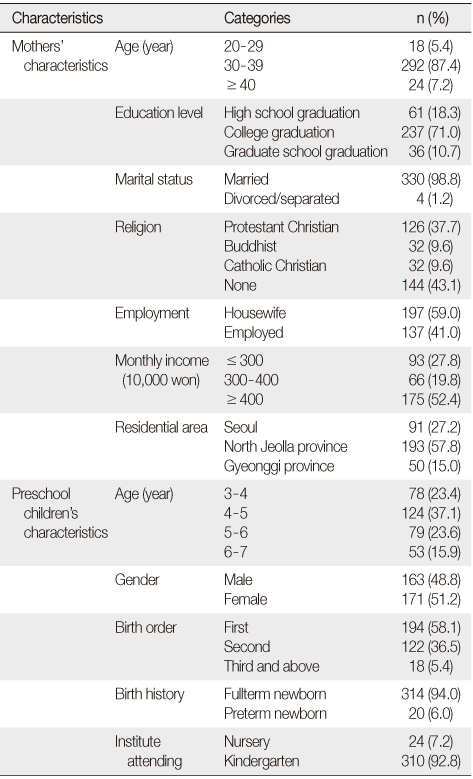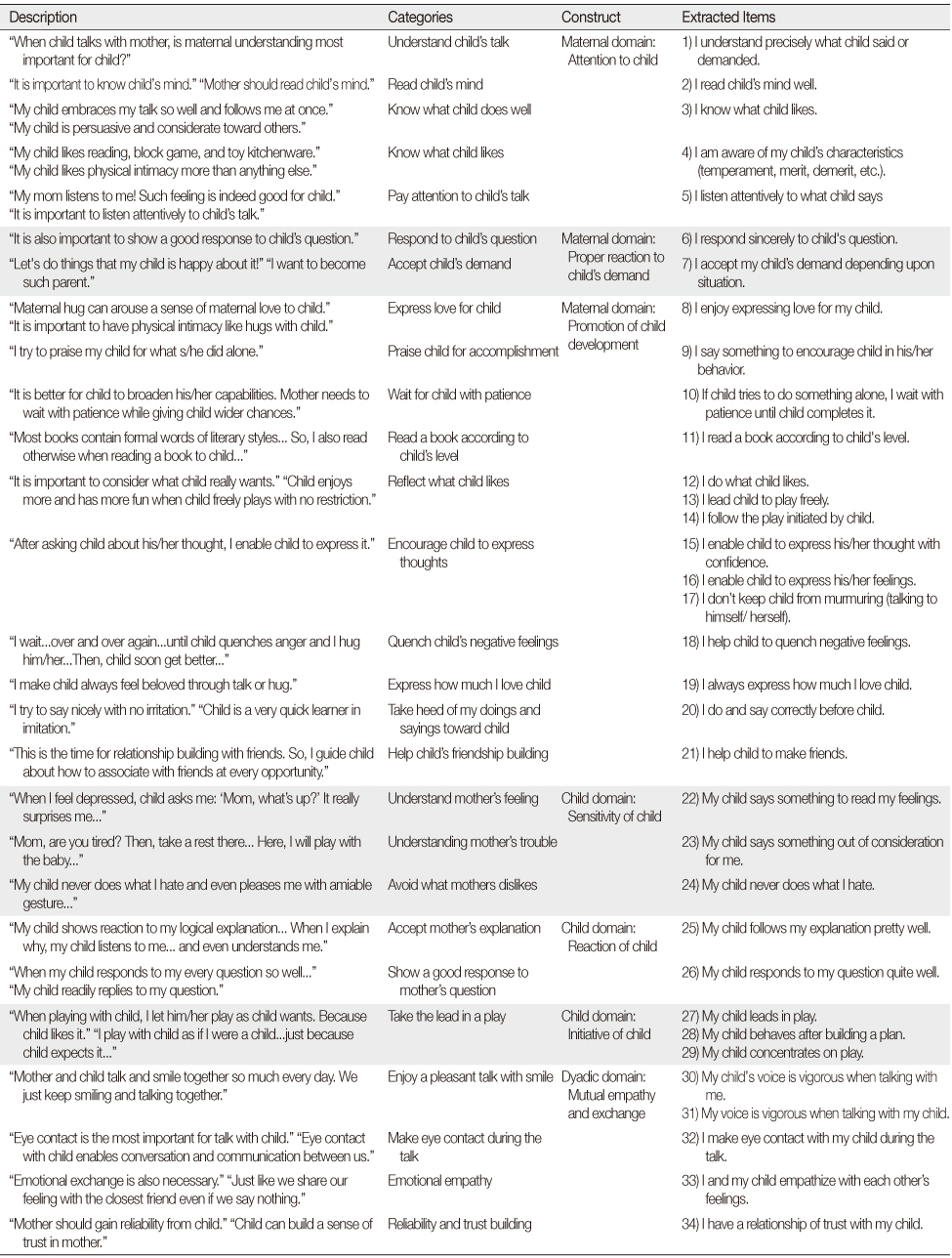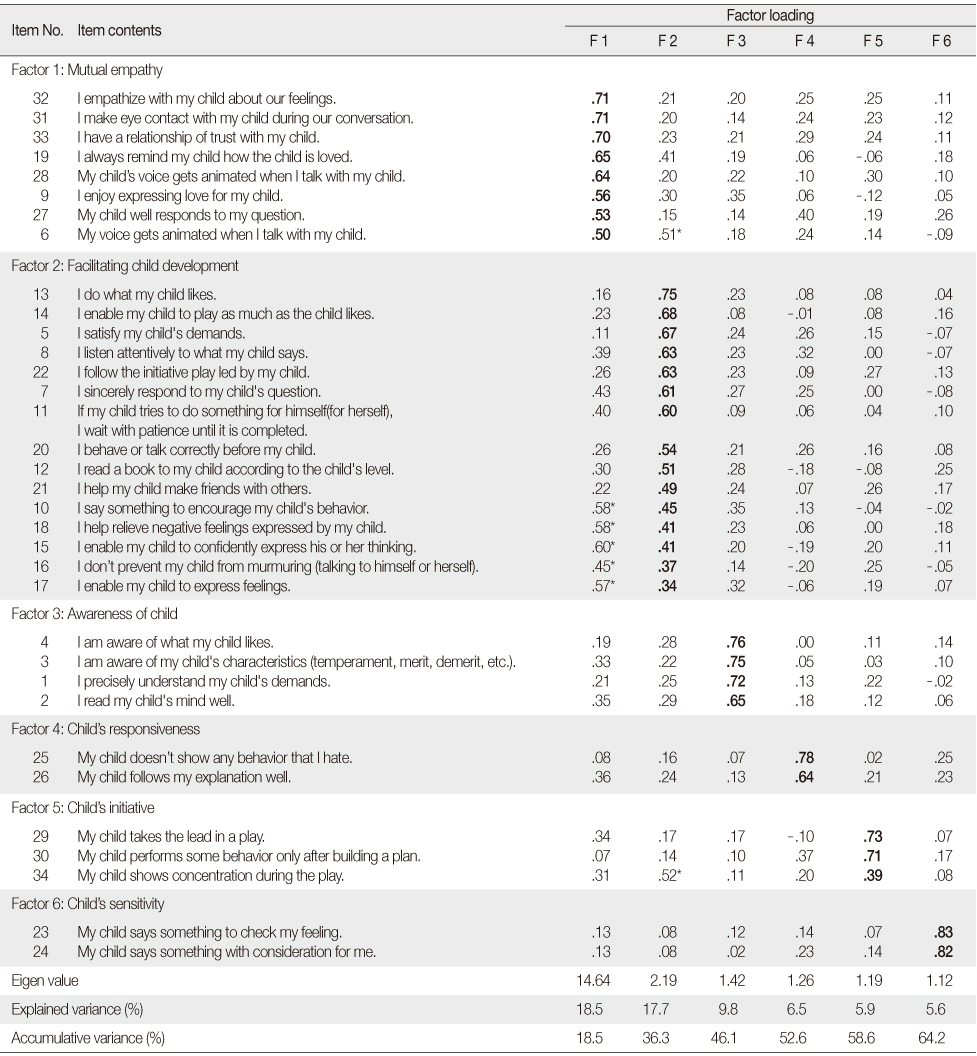Articles
- Page Path
- HOME > J Korean Acad Nurs > Volume 43(1); 2013 > Article
-
Original Article
- Development of a Mother-Preschool Child Interaction Scale
- Sung-Hee Park, Kyung-Sook Bang
-
Journal of Korean Academy of Nursing 2013;43(1):59-68.
DOI: https://doi.org/10.4040/jkan.2013.43.1.59
Published online: February 28, 2013
1Department of Nursing, Kunsan National University, Kunsan, Korea.
2College of Nursing · The Research Institute of Nursing Science, Seoul National University, Seoul, Korea.
- Address reprint requests to: Bang, Kyung-Sook. College of Nursing, Seoul National University, 103 Daehak-ro, Jongno-gu, Seoul 110-799, Korea. Tel: +82-2-740-8819, Fax: +82-2-765-4103, ksbang@snu.ac.kr
© 2013 Korean Society of Nursing Science
Abstract
-
Purpose
- This study was done to develop the self-report Mother-Preschool Child Interaction Scale (MPIS) for mothers of preschool children.
-
Methods
- The scale was based on items derived from literature review and in-depth interviews. A methodological study was used to check reliability and validity and participants were 334 mothers of preschool children enrolled in kindergarten or nursery. Data were analyzed using principal component factor analysis for construct validity, t-test for contrasted group validity, Pearson correlation for criterion related validity and test-retest reliability and Cronbach's α for reliability.
-
Results
- In the final MPIS 34 items identified through factor analysis were included, 6 constructs were derived, and explanatory power was 64.2%. Items on the MPIS were verified through correlation with the interaction observation scale of Kim & Mahoney and MPIS. Results were significant as mothers in the normal group exhibited MPIS scores that were significantly higher than those of mothers in the depressed group. Reliability of MPIS was .96 and test-retest reliability was .92.
-
Conclusion
- MPIS has the advantage of being easy to use, economical, and useful. Consequently, it is expected to be used as a screening tool for promptly and simply identifying the mother-preschool child interaction in diverse nursing practice and research.
This manuscript is based on a part of the first author's doctoral dissertation from Seoul National University.
- 1. Ainsworth MD. Caldwell BM, Ricciuti HN. The development of infant-mother attachment. In: Review of child development research. 1973;Vol. 3. Chicago, IL, University of Chicago Press. 1–94.
- 2. O'Brien Caughy M, Huang KY, Lima J. Patterns of conflict interaction in mother-toddler dyads: Differences between depressed and non-depressed mothers. J Child Fam Stud. 2009;18(1):10–20. http://dx.doi.org/10.1007/s10826-008-9201-6.ArticlePubMedPMCPDF
- 3. Chandra PS, Bhargavaraman RP, Raghunandan VN, Shaligram D. Delusions related to infant and their association with motherinfant interactions in postpartum psychotic disorders. Arch Womens Ment Health. 2006;9(5):285–288. http://dx.doi.org/10.1007/s00737-006-0147-7.ArticlePubMedPDF
- 4. Deater-Deckard K, Pylas MV, Petrill SA. Parent-child interaction system. 1997;London, UK, Institute of Psychiatry.
- 5. Downe-Wamboldt B. Content analysis: Method, applications, and issues. Health Care Women Int. 1992;13(3):313–321. http://dx.doi.org/10.1080/07399339209516006.ArticlePubMed
- 6. Egeland B, Weinfeld N, Hiester M, Lawrence C, Pierce S, Chippendale K, et al. Teaching tasks administration and scoring manual. 1995;Minneapolis, MN, University of Minnesota.
- 7. Erikson EH. Identity and the life cycle. 1959;New York, International University Press, Inc.
- 8. Glascoe FP. Parents' evaluation of developmental status: How well do parents' concerns identify children with behavioral and emotional problems? Clin Pediatr (Phila). 2003;42(2):133–138. http://dx.doi.org/10.1177/000992280304200206.ArticlePDF
- 9. Grazia A, Patrizia V, Antonio R. Children's social competence, peer status, and the quality of mother-child and father-child relationships: A multidimensional scaling approach. Eur Psychol. 2010;15(1):23–33.
- 10. Harrist AW, Waugh RM. Dyadic synchrony: Its structure and function in children's development. Dev Rev. 2002;22(4):555–592.Article
- 11. Kim JM, Mahoney J. Parent-child interaction behavior evaluation. 2009;Seoul, Pakhaksa.
- 12. Kim JM, Sim HS, Lee EJ. Mother-child interactions in preschool children who stutter. J Korean Soc Speech Sci. 2005;12(3):35–48.
- 13. Kuebli J. Young children's understanding of everyday emotions. Young Child. 1994;49(3):36–47.
- 14. Lee EO, Im NY, Park HA, Lee IS, Kim JI, Bae JI, et al. Nursing research and statistical analysis. 2009;Seoul, Soomoonsa.
- 15. NICHD Early Care Research Network. Infant-mother attachment classification: Risk and protection in relation to changing maternal caregiving quality. Dev Psychol. 2006;42:38–58. http://dx.doi.org/10.1037/0012-1649.42.1.38.ArticlePubMed
- 16. Park SH, Bang KS. Concept analysis of mother-child interaction. J Korean Acad Child Health Nurs. 2011;17(2):120–126. http://dx.doi.org/10.4094/jkachn.2011.17.2.120.Article
- 17. Parke RD. Sackett GP. Parent-infant interaction: Progress, paradigms, and problems. In: Observing behavior: Vol. 1. theory and applications in mental retardation. 1978;Baltimore, University Park Press.
- 18. Rhee MK, Lee YH, Jung HY, Choi JH, Kim SH, Kim YK, et al. A standardization study of beck depression inventory 2-Korean version (K-BDI): Validity. Korean J Psychopathol. 1995;4(1):96–104.
- 19. Song HN. The influence of children's involvement in mother-child interactions on mothers' reactive behaviors: The moderating effect of children's emotionality. Korean J Hum Dev. 2011;18(4):19–33.
- 20. Song HN, Choi KS. The influence of children's and mother's emotional expressiveness in mother-child interaction settings on children's social competence. J Korean Home Econ Assoc. 2006;44(11):51–65.
- 21. Suh EH. Statistical analysis using SPSS 18.0: PASW statistics. 2010;Paju, Freedom Academy.
- 22. Tabachnick BG, Fidell LS. Using multivariate statistics. 2001;4th ed. Boston, MA, Allyn & Bacon.
- 23. Walker LO, Avant KC. Strategies for theory construction in nursing. 2005;4th ed. Upper Saddle River, NJ, Prentice Hall.
- 24. Weinfield NS, Ogawa JR, Egeland B. Predictability of observed mother-child interaction from preschool to middle childhood in a high-risk sample. Child Dev. 2002;73(2):528–543. http://dx.doi.org/10.1111/1467-8624.00422.ArticlePubMed
REFERENCES
Figure & Data
REFERENCES
Citations

- Structural Equation Modeling of the Interaction between Mothers and Preschool-Age Children
Hyun-Yi Chai, Mi-Young Choi
Journal of Korean Academy of Nursing.2021; 51(5): 630. CrossRef - Cognitive Ability and Related Factors in Preschoolers Born Prematurely
Young Mee Ahn, Sangmi Lee
Child Health Nursing Research.2019; 25(4): 468. CrossRef - Parenting Stress and Maternal–Child Interactions Among Preschool Mothers From the Philippines, Korea, and Vietnam: A Cross-Sectional, Comparative Study
Yong-Sook Eo, Ji-Soo Kim
Journal of Transcultural Nursing.2018; 29(5): 449. CrossRef - A Model for Role Transition of Older Mothers with Preschool Children
Mee Kyung Kim, Hyang Mi Jung
Child Health Nursing Research.2018; 24(1): 37. CrossRef - Factors associated with Smartphone Overdependency in Preschool Children
MinJung Lee, SungHee Park
Child Health Nursing Research.2018; 24(4): 383. CrossRef - Relationship between Preschool Child-Mother Interaction, Child's Health Status, Health-Related Quality of Life, and Social Development.
Sunghee Park
Child Health Nursing Research.2014; 20(4): 255. CrossRef
Demographic Characteristics of the Preschool Children and Mothers (N=334)
Searching Constructs and Extracted Items through Description of In-depth Interviews
Factor Analysis of Mother-Preschool Child Interaction Scale (N=334)
*This item included where the factor loading was smaller.
Contrasted Group Validity of Mother-Preschool Child Interaction Scale (N=334)
Criterion-related Validity of Mother-Preschool Child Interaction Scale (N=32)
Scale I=Mother-Preschool Child Interaction Scale; Scale II=Scale of Kim & Mahoney (2009).
*This item included where the factor loading was smaller.
Scale I=Mother-Preschool Child Interaction Scale; Scale II=Scale of Kim & Mahoney (2009).
 KSNS
KSNS
 E-SUBMISSION
E-SUBMISSION





 Cite
Cite

